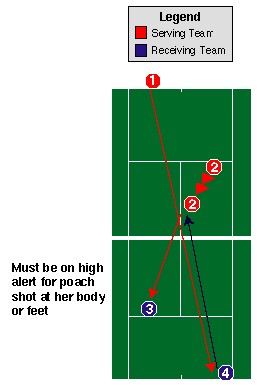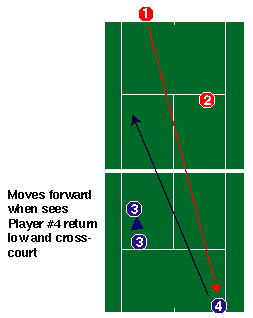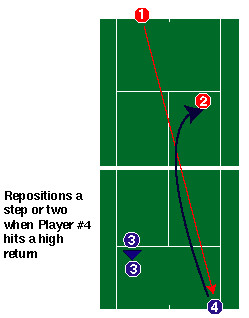<% ns_puts [nsv_get mkm_includes mkm_oldContentHeader_inc] %>
Strategy Lesson
of the Week
Develop "Fast Eyes" For Better Reaction at the Net
Part 2: When Partner Is Receiving
Written by Monty Basynet, TennisONE Editor
Go to Part 1 of this lesson
As I said in Part 1, fast hands and fast eyes go together to make a good
doubles player. Let's look how this applies when your partner is receiving.
 Sensing the Poacher
Sensing the Poacher
Once the serve has hit in the service box towards Player #4, Player #3
should immediately pick on any sudden movements by the opposite
net player, Player #2. This way Player #3 will be better
prepared for a poaching shot which is generally aimed at the opposing net
person. The most likely scenario for this is when the server has hit a
good serve down the middle. This presents Player #2 with a good opportunity
to poach and drive Player #4's return at Player #3. Player #3 shouldn't
retreat, just be on high alert for the drive at her body or feet.
 Moving with the Direction of the Return
Moving with the Direction of the Return
If you know in advance where your partner is going to return serve, than
you can wait and focus on that half of the court. But chances are the return
could go either down the line or crosscourt. Therefore, to react quicker
at the net, Player #3 must learn to pick up the direction of the return
at the earliest possible moment. Usually Player #3 can position herself
to call the service line and see how and where (as well as listen)
Player #4 is hitting the return. At the very least, Player #3 must
learn to see the direction of the ruturn as soon as it passes in front of
her and lean more towards that direction (don't wait to react till the ball
has crossed the net and your opponent is lining up a shot).
 Seeing the Height of the Ball Moving with the
Direction of the Return
Seeing the Height of the Ball Moving with the
Direction of the Return
Just as the direction of the return tends to vary, so does the height of
the return. Of course the ideal return is a low crosscourt drive that forces
Player #2 to volley up. But again in a realistic match situation, the height
of the return can vary dramatically. The principle for Player #3
to follow here is that any high returns, regardless whether it's a drive
or a lob, Player #3 should not move forward. In most instances,
a high return, especially a lob or a floater, will give Player #3 enough
time to take a step or two back and reposition herself. I say "reposition"
because Player #3 should not be caught with her weight falling backwards
on her heels, which makes it almost impossible to effectively handle
any shot aimed at her. She must reestablish her basic volleying position,
with her weight slightly forward, ready to handle any shot that comes her
way. Now if Player #4 hits a low return, then Player #3 should shift her
weight more slightly forward and look to move towards the net and cut off
anything within close range.
Conclusion
The sooner you can see the ball when your partner is hitting her serve
or making her return, the quicker your hands can react at the net. The
combination of quick eyes and hands means sharper, cleaner volley. And
that means winning volleys.
Go to Part 1 of this lesson
Send in Your Strategy Questions to TennisONE
If you think you have a good TennisONE Strategy Question, please send an
email to: question@tennisone.com.
<% ns_puts [nsv_get mkm_includes mkm_oldContentFooter_inc] %>
 Sensing the Poacher
Sensing the Poacher Moving with the Direction of the Return
Moving with the Direction of the Return Seeing the Height of the Ball Moving with the
Direction of the Return
Seeing the Height of the Ball Moving with the
Direction of the Return